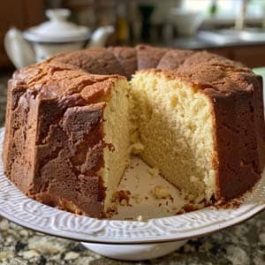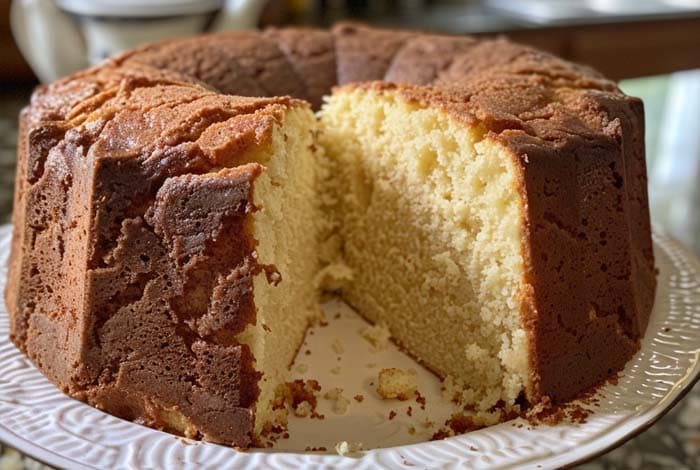Introduction to Homemade Pound Cake
The pound cake is a timeless classic that has graced tables for centuries, with its origins tracing back to Europe in the early 1700s. The name itself comes from the traditional recipe that called for a pound each of four key ingredients: flour, butter, eggs, and sugar. This simple yet precise formula was designed for ease of remembering in an era before cookbooks were commonplace. Over time, the pound cake has become a beloved staple across the world, particularly known for its dense, moist texture and rich, buttery flavor.
Homemade recipes hold a special place in the culinary world, offering a touch of authenticity and personalization that store-bought versions simply cannot match. The act of baking a pound cake from scratch is not just about following a recipe; it’s about continuing a tradition, creating memories, and sharing love through the universal language of food. In today’s fast-paced world, the importance of homemade recipes is ever more poignant, serving as a reminder of the simple pleasures in life and the joy of baking for others.
The Basics of Pound Cake
Traditional Ingredients and Their Roles
The classic pound cake formula is a masterpiece of culinary simplicity, yet each ingredient plays a crucial role in creating the cake’s signature texture and flavor:
- Flour: Provides the structure, giving the cake its form and density.
- Butter: Adds richness, moisture, and the unmistakable flavor that pound cakes are known for.
- Eggs: Bind the ingredients together, contribute to the cake’s rise, and add to its moistness.
- Sugar: Sweetens the cake and contributes to the golden crust that many find irresistible.
The Classic Pound Cake Formula
Originally, the pound cake was made with a pound of each of these ingredients, which made the cake incredibly dense and rich. This straightforward formula was easy to remember, making the pound cake a popular recipe among home bakers for generations.
Variations Over the Years
As the pound cake recipe traveled across continents and cultures, it underwent various transformations. Bakers began experimenting with the addition of leavening agents like baking powder to make the cake lighter. The introduction of dairy products such as milk or cream, as well as flavorings like vanilla, lemon, and almond extract, further diversified the pound cake’s flavor profile and texture.
In some regions, the proportions of the original ingredients were adjusted to suit local tastes or to make the cake more accessible. Despite these changes, the essence of the pound cake remains the same: a rich, dense cake that serves as a versatile canvas for a variety of flavors and toppings.
Through its evolution, the pound cake has remained a beloved dessert, symbolizing the comfort of home and the joy of baking from scratch. Its enduring popularity is a testament to the timeless appeal of simple, homemade recipes that bring people together.
Essential Ingredients for a Perfect Pound Cake
Creating the perfect pound cake requires more than just following a recipe; it’s about understanding the role and quality of each ingredient. Here’s a breakdown of the essential components:
- Flour: The type of flour can significantly affect the cake’s texture. All-purpose flour is commonly used for its reliability and availability, but cake flour can be used for a lighter crumb. Measure flour using the spoon-and-level method to avoid a dense cake.
- Eggs: Eggs should be at room temperature to blend more smoothly with the batter, contributing to a uniform texture. The quantity of eggs can vary, but they are crucial for structure and moisture.
- Butter: Use unsalted, softened butter to control the cake’s saltiness and ensure it creams well with sugar. This step is vital for a tender crumb and rich flavor.
- Sugar: Fine granulated sugar dissolves more easily, ensuring a smooth batter without grittiness. It also helps to create a fine, tender crumb.
- Milk: Often the secret to a moist pound cake, milk (or a dairy alternative like buttermilk or cream) adds moisture and richness. Ensure it’s at room temperature to mix evenly into the batter.
- Leavening agents: While traditional recipes may not call for them, a small amount of baking powder and salt can help the cake rise and enhance its flavor.
- Extracts: Vanilla extract is a must for its warm, classic flavor. Lemon or coconut extracts can be added for a subtle depth of flavor, making the cake more aromatic.
Step-by-Step Pound Cake Recipe
Preparing Your Ingredients and Tools
Start by gathering all your ingredients and ensuring they’re at room temperature. This uniformity helps the ingredients blend more seamlessly, contributing to a smoother batter. Preheat your oven to 325°F (165°C), and prepare your baking pan by greasing it and lightly dusting it with flour.
Mixing the Batter: Techniques for a Smooth Blend
- Creaming Butter and Sugar: Begin by creaming the softened butter with the sugar until the mixture is light and fluffy. This process incorporates air into the batter, setting the foundation for a light cake.
- Adding Eggs: Add the eggs one at a time, beating well after each addition. This gradual incorporation ensures each egg is fully emulsified into the batter.
- Incorporating Dry and Wet Ingredients: Alternately add the dry ingredients (flour, baking powder, and salt) with the milk, starting and ending with the dry ingredients. This method helps maintain the structure while adding moisture.
- Flavoring: Finally, stir in the vanilla extract and any other extracts you’re using. Mix until just combined to avoid overmixing, which can lead to a tough cake.
Baking: Temperature and Time for the Perfect Crust
Pour the batter into the prepared pan and smooth the top. Bake in the preheated oven. The cake is done when a toothpick inserted into the center comes out clean, usually after about 60-70 minutes. Avoid opening the oven frequently, as this can cause the cake to fall.
Cooling and Serving Suggestions
Let the cake cool in the pan on a wire rack for about 20 minutes before inverting it onto the rack to cool completely. This resting period allows the cake to set and makes it easier to remove from the pan.
Once cooled, the pound cake can be served as is or dressed up with a dusting of powdered sugar, a glaze, or fresh berries and whipped cream. Pound cake’s beauty lies in its simplicity and versatility, making it a delightful treat for any occasion.
Advanced Tips and Tricks
Achieving the perfect crumb and texture in a pound cake involves precision and patience. One key tip is to ensure all ingredients are at room temperature to facilitate a smoother blend. Overmixing the batter can develop the gluten too much, leading to a tough cake, so mix just until the ingredients are combined. Additionally, investing in an oven thermometer can help you bake at the exact temperature, preventing uneven baking.
To prevent common pound cake issues like sinking or tough crusts, avoid opening the oven door frequently during baking, as temperature fluctuations can affect the cake’s rise. If the cake is browning too quickly, cover it loosely with aluminum foil. Ensuring accurate measurements of ingredients, especially leavening agents, can prevent the cake from falling or becoming too dense.
Decorating and Serving Ideas
Simple garnishes can significantly enhance your pound cake’s presentation and flavor. A dusting of powdered sugar, a drizzle of honey, or a sprinkle of edible flowers adds elegance with minimal effort. For a zesty touch, lemon or orange zest works beautifully.
Creative serving suggestions can turn your pound cake into a centerpiece for any occasion. Slice the cake and layer it with fresh berries and whipped cream for a delightful trifle. For a festive touch, serve slices with a warm fruit compote or a scoop of ice cream. Pound cake also pairs wonderfully with coffee or tea, making it perfect for brunch or afternoon gatherings.
FAQs
- What causes a dry pound cake? A dry pound cake often results from overbaking, using too much flour, or not enough butter or eggs. Ensure accurate measurements and keep an eye on the baking time.
- Can I substitute ingredients in a pound cake recipe? Yes, but with caution. For example, you can use cake flour instead of all-purpose for a lighter texture or substitute some of the butter with yogurt for a slightly healthier version. However, major substitutions can alter the cake’s texture and flavor.
- How do I store pound cake to keep it moist? Wrap the cooled pound cake tightly in plastic wrap or store it in an airtight container. It can be kept at room temperature for several days or refrigerated for longer storage. To revive slices, a quick zap in the microwave can bring back some of the moisture.

Homemade Pound Cake Recipe
Equipment
- 10-cup Bundt pan
- Electric mixer
- Mixing bowls
- Measuring cups and spoons
- Wire rack for cooling
Ingredients
- 3 cups all-purpose flour spooned and leveled
- 1 teaspoon baking powder
- 1/2 teaspoon salt
- 1 1/2 cups unsalted butter room temperature (3 sticks)
- 3 cups fine granulated sugar
- 5 large eggs room temperature
- 3/4 cup whole milk room temperature
- 2 teaspoons pure vanilla extract
- Optional: 1/4 teaspoon pure lemon extract 1/4 teaspoon pure coconut extract
Instructions
- Preheat your oven to 325°F (165°C). Grease and flour your Bundt pan.
- In a bowl, whisk together flour, baking powder, and salt. Set aside.
- In a large mixing bowl, cream the butter until smooth. Gradually add sugar and beat until fluffy.
- Add eggs one at a time, fully incorporating after each addition. Mix in vanilla and any other extracts you're using.
- Alternately add dry ingredients and milk to the butter mixture, starting and ending with dry ingredients. Mix until just combined.
- Pour batter into the prepared pan, smoothing the top with a spatula.
- Bake for 1 hour 10 minutes, or until a toothpick inserted comes out clean.
- Let the cake cool in the pan for 20 minutes, then turn out onto a wire rack to cool completely.
Notes
- Ensure all ingredients are at room temperature to achieve a smooth, even batter.
- For a lighter crumb, you can substitute cake flour for all-purpose flour.
- This cake stores well wrapped tightly at room temperature for up to 3 days, or refrigerated for up to a week.
- Experiment with different extracts like almond or orange for a unique twist on this classic recipe.

